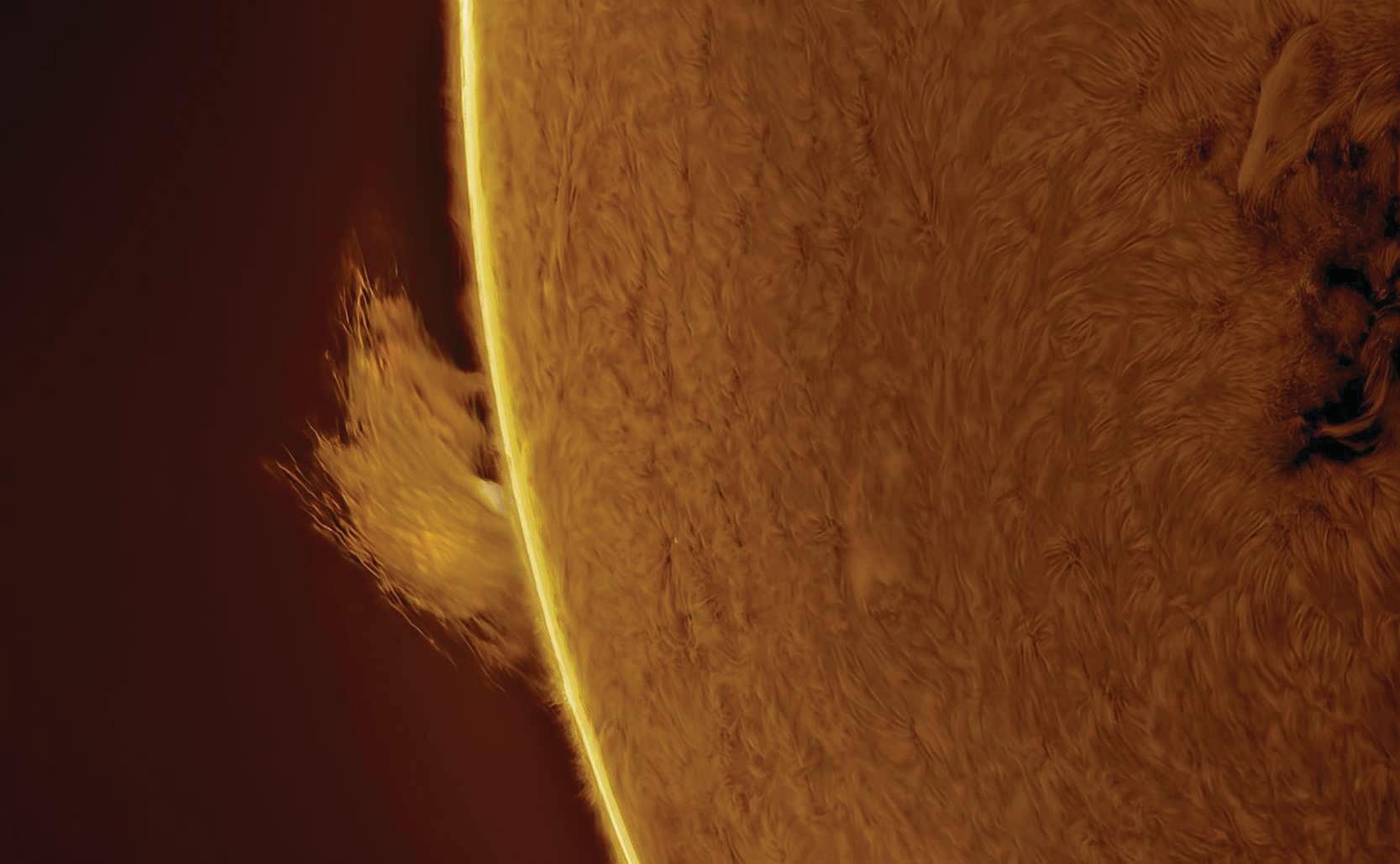
Jay Bolt, Crigglestone, West Yorkshire, 18 July 2022
Jay says: "I had been capturing sunspots when I noticed a huge prominence forming on the Sun's limb. The seeing was unusually good early in the morning, allowing for very precise focusing and capturing of the plasma eruption. Solar activity has been steadily increasing over the last few years, and I am particularly pleased with the magnetic detail that processing has brought out on the chromosphere."
Equipment: Altair Hypercam 174M camera, Explore Scientific AR127mm refractor, Daystar Quark Chromosphere Ha eyepiece filter, Sky-Watcher EQ6-R mount
Exposure: 1,500 frames of SER format video, best 20% selected
Software: AutoStakkert!, Photoshop, Astra Image, Topaz DeNoise, Topaz Sharpen
Jay's top tips: "For solar imaging using a Quark Chromosphere, aim for exposures of 5-10ms for the chromosphere to 'freeze' the effects of seeing. I use gain and the histogram to achieve exposure rates of 5ms on my Altair 174M, and take 2,000 to 3,000 exposures, with the histogram peaking around 60 per cent and taking care that the top end is not clipped. For the prominences, ignore the histogram and increase exposure to bring out the detail. Typically this is around max gain and 20ms on my camera. I then shoot for 20-25 seconds. My image is a composite: the prominences are overlaid onto the chromosphere, then colourised."
Supermoon over the Needles
Cenk Albayrak-Touyé, Highcliffe beach, Dorset, 13 July 2022
Cenk says: "I used the PhotoPills app to work out the direction of moonrise. Right on cue, I glimpsed some orange behind the Needles. After running down the beach with my tripod to adjust the angle slightly, I managed to capture the resulting photo."
Esta historia es de la edición October 2022 de BBC Sky at Night Magazine.
Comience su prueba gratuita de Magzter GOLD de 7 días para acceder a miles de historias premium seleccionadas y a más de 9,000 revistas y periódicos.
Ya eres suscriptor ? Conectar
Esta historia es de la edición October 2022 de BBC Sky at Night Magazine.
Comience su prueba gratuita de Magzter GOLD de 7 días para acceder a miles de historias premium seleccionadas y a más de 9,000 revistas y periódicos.
Ya eres suscriptor? Conectar

Could We Find Aliens by Looking for Their Solar Panels?- Designed to reflect ultraviolet and infrared, the panels have a unique fingerprint
Researchers searching for life beyond Earth spend a lot of time thinking about what telltale signs might be detectable astronomically. Forms of unambiguous evidence for the presence of life on another world are known as biosignatures. By extension, techno signatures are indicators of activity by intelligent, civilisation-building life.

Antimatter- In our continuing series, Govert Schilling looks at antimatter, the strange counterpart to most of the matter filling our Universe
Particles and corresponding antiparticles are very much alike, except they have opposite electrical charges. For instance, the antiparticle of the electron - known as the positron - has the same tiny mass, but while electrons carry a negative electrical charge, positrons are positively charged.

Where Have All The Milky Way's Early Stars Gone?- Our Galaxy has a curious lack of pristine stars
The Big Bang produced a Universe filled almost exclusively with hydrogen and helium; all other elements - what astronomers call metals - were produced by stars, supernovae and everything that happens later. So if you can pick out a pristine star with no metals polluting it from among the billions in the Milky Way, then you are likely to have a star dating from our Galaxy's earliest days.

Inside The Sky At Night - Two years ago, exoplanet scientist Hannah Wakeford received some of the first data from the JWST
Two years ago, exoplanet scientist Hannah Wakeford received some of the first data from the JWST. In July's Sky at Night, we discovered what she's learned since then.

How to stack DSLR data in Siril
Easily combine multiple frames to boost detailin your astro photos

Lunar occultation of Saturn
You'll need to strike a balance on 21 August to capture the Moon covering the ringed planet

How to plot a variable star light curve
A rewarding project to chart stars that change brightness

Smartphone photography with a telescope
Mary Mcintyre explains how to get impressive night-sky images using your phone

Once-a-century solar storm is overdue
If a Carrington Event struck today it would be catastrophic, says Minna Palmroth

The new era of human spaceflight
There's been a step-change in crewed space missions since the dawn of the 21st century. Ben Evans charts its course and looks ahead to future horizons